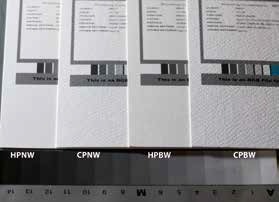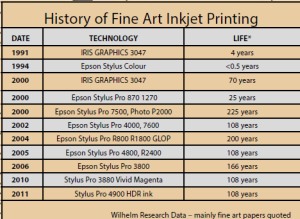articles/Paper/hahn-bar-satin-page5
The Great Paper Chase - Hahnemuhle Fineart Baryta Satin 310 - part 5 of 1 2 3 4 5
by Mike McNamee Published 01/12/2014

What's in a name
If you are selling art to galleries, the name of the paper can be important. 'Staples Jetlag Bright' does not carry the cache of say Arches Velin Museum Rag or Hahnemuhle Museum Etching - no matter how good your sales patter is! Artists and art dealers know their papers.
Epson's tripple-coated Signature Worthy range of fine art papers are their most expensive papers. RIGHT: Deterioration in the fluorescence activity of the OBA causes the paper to fade back to base yellow. The indicated area between the yellow arrows has been exposed to daylight during storage and has almost stopped its brightening activity - in daylight it was yellowed.

HISTORY
Some quotes from A 15-Year History of Digital Printing Technology and Print Permanence in the Evolution of Digital Fine Art Photography - From 1991 to 2006 by Henry Wilhelm
Digital printing of fine art photographs - and a broad-based concern about the permanence of digital prints - can be traced to the founding of Nash Editions in Manhattan Beach, California, in 1991. At that time, the only printer capable of producing high-quality, large photographic prints (up to 34x46 inches) on a wide range of papers and canvas was the Iris Graphics Model 3047 inkjet printer made by Iris Graphics, Inc. in Bedford, Massachusetts. The Iris 3047, which had been designed for direct digital graphic arts proofing, was an expensive machine, costing $126,000.
In 1994, Adamson became the first Iris studio to print an exhibition using the then newly introduced Lyson Fine Arts inkset: 'The Washington Portfolio.' For use by the art reproduction market, which for various reasons often felt uncomfortable with telling customers they were buying inkjet prints, Jack Duganne coined the name 'Giclee' for inkjet prints as an analogous term to 'Serigraph'. The introduction of the Epson Stylus Pro 7500 (24-inch) and 9500 (44-inch) pigmented ink printers in 2000 started a period of rapid change in the fine art printing business.
One can cite the 1994 introduction of the Epson Stylus Colour 720 dpi printer - which came to market only five years after the Iris 3047 became available - as the start of low-cost inkjet photo printing. Quite suddenly, Epson found itself in the photography business.
But beginning with the Epson UltraChrome pigmented ink set introduced in 2002 with the Epson 9600 printer, these problems started to be resolved...
Please Note:
There is more than one page for this Article.
You are currently on page 5
- The Great Paper Chase - Hahnemuhle Fineart Baryta Satin 310 page 1
- The Great Paper Chase - Hahnemuhle Fineart Baryta Satin 310 page 2
- The Great Paper Chase - Hahnemuhle Fineart Baryta Satin 310 page 3
- The Great Paper Chase - Hahnemuhle Fineart Baryta Satin 310 page 4
- The Great Paper Chase - Hahnemuhle Fineart Baryta Satin 310 page 5
1st Published 01/12/2014
last update 09/12/2022 14:54:52
More Paper Articles
There are 0 days to get ready for The Society of Photographers Convention and Trade Show at The Novotel London West, Hammersmith ...
which starts on Wednesday 15th January 2025





